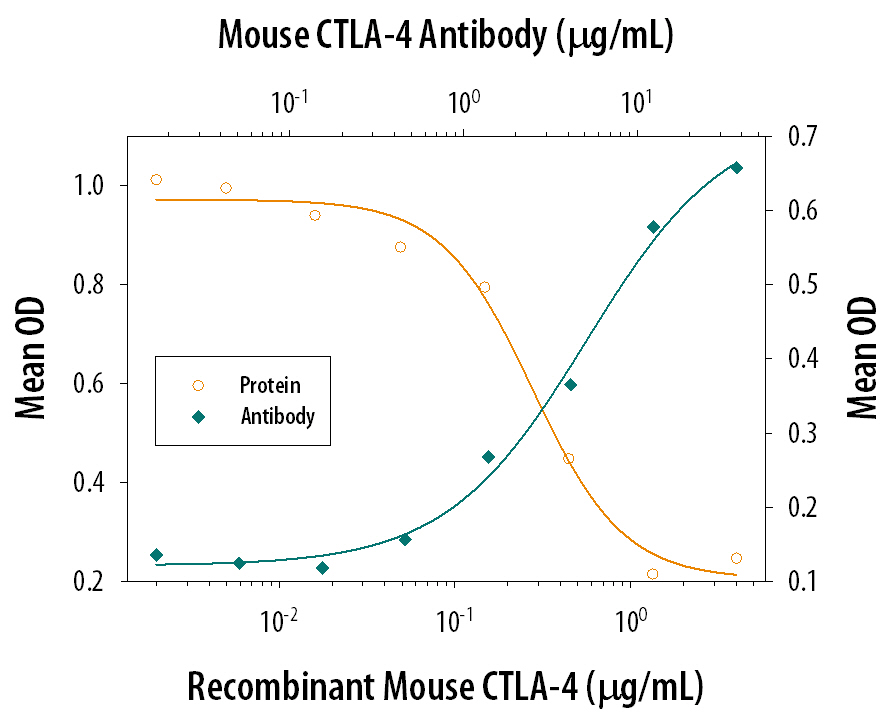Mouse CTLA-4 Antibody Summary
Ala36-Phe161
Accession # XP_001479180
Applications
Please Note: Optimal dilutions should be determined by each laboratory for each application. General Protocols are available in the Technical Information section on our website.
Scientific Data
 View Larger
View Larger
CTLA‑4 Inhibition of B7‑1/CD80-induced IL‑2 Secretion and Neutralization by Mouse CTLA‑4 Antibody. Recombinant Mouse CTLA‑4 Fc Chimera (Catalog # 434-CT) inhibits Recombinant Human B7‑1/CD80 Fc Chimera (Catalog # 10133-B1) induced IL‑2 secretion in the Jurkat human acute T cell leukemia cell line in a dose-dependent manner (orange line), as measured by the Human IL‑2 Quantikine ELISA Kit (Catalog # D2050). Inhibition of Recombinant Human B7‑1/CD80 Fc Chimera (3 µg/mL) activity elicited by Recombinant Mouse CTLA‑4 Fc Chimera (1 µg/mL) is neutralized (green line) by increasing concentrations of Mouse CTLA‑4 Monoclonal Antibody (Catalog # MAB434). The ND50 is typically 2.5-10 µg/mL in the presence of PHA (10 µg/mL).
Reconstitution Calculator
Preparation and Storage
- 12 months from date of receipt, -20 to -70 °C as supplied.
- 1 month, 2 to 8 °C under sterile conditions after reconstitution.
- 6 months, -20 to -70 °C under sterile conditions after reconstitution.
Background: CTLA-4
CTLA-4 and CD28, together with their ligands B7-1 and B7-2, constitute one of the dominant costimulatory pathways that regulate T and B cell responses. CTLA-4 and CD28 are structurally homologous molecules that are members of the immunoglobulin (Ig) gene superfamily. Both CTLA-4 and CD28 are composed of a single Ig V‑like extracellular domain, a transmembrane domain and an intracellular domain. CTLA-4 and CD28 are both expressed on the cell surface as disulfide-linked homodimers or as monomers. The genes encoding these two molecules are closely linked on human chromosome 2. CTLA-4 was originally identified as a gene that was specifically expressed by cytotoxic T lymphocytes. However, CTLA-4 transcripts have since been found in both Th1 and Th2, and CD4+ and CD8+ T cell clones. Whereas, CD28 expression is constitutive on the surfaces of 95% of CD4+ T cells and 50% of CD8+ T cells and is down regulated upon T cell activation, CTLA-4 expression is upregulated rapidly following T cell activation and peaks approximately 24 hours following activation. Although both CTLA-4 and CD28 can bind to the same ligands, CTLA-4 binds to B7-1 and B7-2 with 20-100-fold higher affinity than CD28. The physiological role of CTLA-4 in T cell costimulation is currently being studied. Recombinant human or mouse CTLA-4/Fc chimera preparations produced at R&D Systems have been shown to bind both B7-1 and B7-2 with high affinity and to inhibit CD28 signalling competitively.
- Lenschow, D.J. et al. (1996) Annu. Rev. Immunol. 14:233.
- Hathcock, K.S. and R.J. Hodes (1996) Advances in Immunol. 62:131.
- Ward, S.G. (1996) Biochem. J. 318:361.
Product Datasheets
Citation for Mouse CTLA-4 Antibody
R&D Systems personnel manually curate a database that contains references using R&D Systems products. The data collected includes not only links to publications in PubMed, but also provides information about sample types, species, and experimental conditions.
1 Citation: Showing 1 - 1
-
Dopamine, through the extracellular signal-regulated kinase pathway, downregulates CD4+CD25+ regulatory T-cell activity: implications for neurodegeneration.
Authors: Kipnis J, Cardon M, Avidan H, Lewitus GM, Mordechay S, Rolls A, Shani Y, Schwartz M
J. Neurosci., 2004-07-07;24(27):6133-43.
Species: Mouse
Sample Types: Whole Cells
Applications: Functional Assay
FAQs
No product specific FAQs exist for this product, however you may
View all Antibody FAQsReviews for Mouse CTLA-4 Antibody
There are currently no reviews for this product. Be the first to review Mouse CTLA-4 Antibody and earn rewards!
Have you used Mouse CTLA-4 Antibody?
Submit a review and receive an Amazon gift card.
$25/€18/£15/$25CAN/¥75 Yuan/¥2500 Yen for a review with an image
$10/€7/£6/$10 CAD/¥70 Yuan/¥1110 Yen for a review without an image

